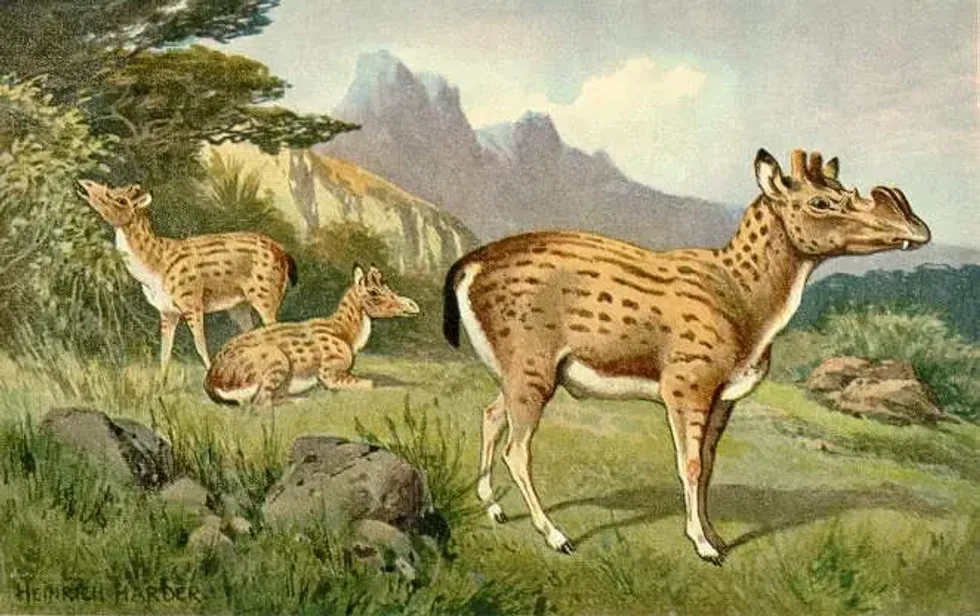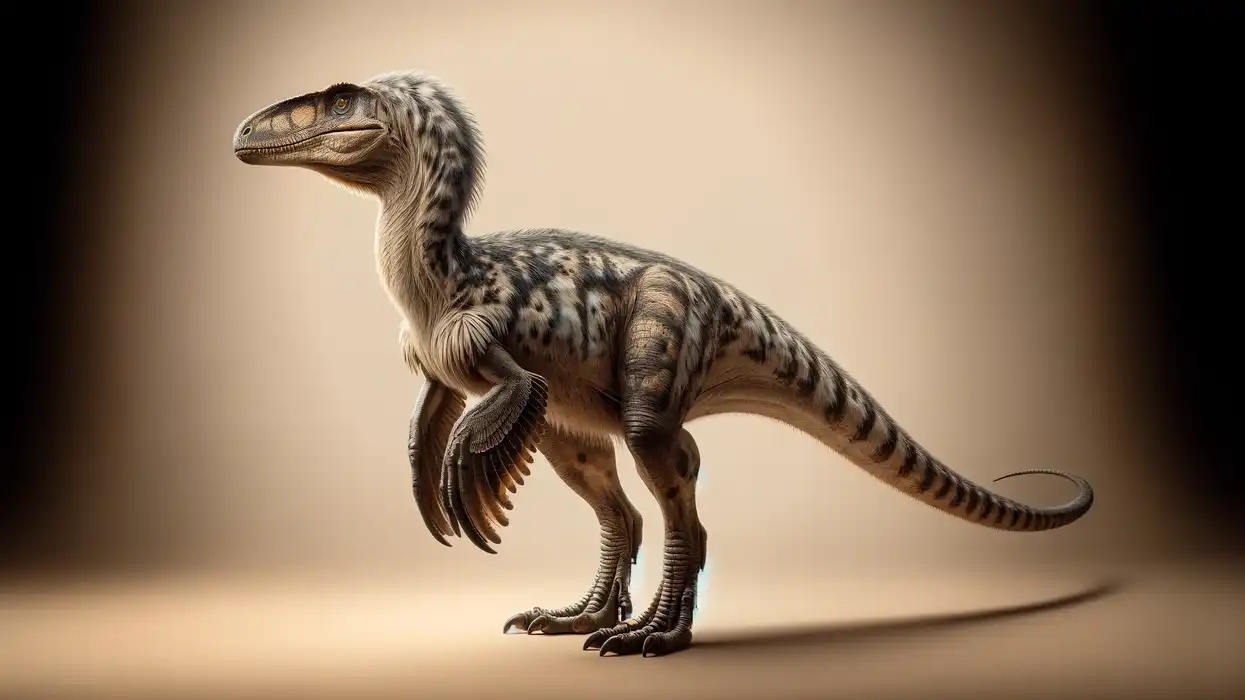Protoceras was an animal that belonged to an extinct genus of protoceratid individuals. The meaning of the name refers to 'first horns.'
The name was given by Marsh (1891) and Carroll (1988). According to references, they were divided into subfamilies by Matthew (1908), Webb (1981), Prothero (1998), Webb et al. (2003), and Prothero and Ludtke (2007).
There were three species classification in the genus Protoceratidae: Protoceras celer, Protoceras neatodelpha, and Protoceras skinneri. It was endemic to North America, existing for approximately 13 million years but went extinct about 17 million years ago.
The Protoceratidae represented the early ancestors of artiodactyls from North America, with exquisite skull decorations. Many of the more basic taxa did not have horns, but most of the males possessed horns on the frontal, parietal, nasal, and occipital bones. Females generally did not have horns.
Instead, they had rough patches in the same place. Protoceratid animals range in weight from 44-771.62 lb (20-350 kg), and they were also exhibited sexual dimorphism in terms of overall body size.
For more than a century, the phylogenetic status of protoceratid animals, camelids, and ruminants has been controversial.
The morphology of the basal (Leptotragulus) and derivative (Syndyoceras) showed that the protoceratid animals were similar to ruminants. In contrast, the previous description of the disarticulated protoceratid animals (Protoceras celer) suggested that the protoceratid mammals were closely related to the camelids.
This conflicting evidence indicated that several features in the protoceratid mammals lineage were reversed and questioned the efficacy of basic skull features in artiodactyl phylogeny.
Here, we provide an additional description of P. Celery rock. The descriptions on P. Celeryrock were based on data generated by computed tomography, which allowed to obtain images of the petrous bones of the skull in situ.
The research results showed that the petrosal morphology of P. celer was the same as that of other protoceratid animals, which means that, contrary to former evidence, petrosal morphology was preserved within Protoceratidae.
To learn more about other extinct animals, you can also check out these Caviramus and Brachytrachelopan.
Protoceras Interesting Facts
Was the Protoceras a dinosaur?
No, Protoceras was not a dinosaur. Paleontologists retrieved information that shows that they were American mammals with one horn. It belonged to an extinct family, Protoceratidae.
The members of this family were endemic North American artiodactyls. The phylogenetic position of this and other protoceratids as compared to ruminants and camelids has been controversial for more than a hundred years.
The petrosal phylogeny of subtypes Leptoragulus and Syndynoceras fossil has indicated that these protoceratids were similar to ruminants. However, a former petrosal description suggested similar to camelids. The subfamily Protoceratinae consisted of various smaller horned animals, including Protoceras.
How do you pronounce 'Protoceras'?
The Protoceras pronunciation is 'pro-to-cer-as'.
What type of prehistoric animal was a Protoceras?
Protoceras' name means 'first horns'. It was an American mammal of an extinct genus of Artiodactyla, placed in the family Protoceratidae. It was a native to North America. For the first time, it occurred in the early Uintan (middle Eocene) and endured into the Latest Hemphillian (early Pliocene period) of North and Central America.
Protoceratidae was subdivided into three subfamilies: Leptotragulinae, the Protoceratinae, and the Synthetoceratinae. The primary subfamily consisted of basal Eocene hornless mammals. The second consisted of smaller horned animals, including Protoceras.
In which geological period did the Protoceras live?
Record of history shows that Protoceras lived from the Oligocene to the Miocene, existing for approximately seventeen million years.
When did the Protoceras become extinct?
According to history, the Protoceratinae taxa existed from the Oligocene (Whitneyan) to the beginning of the Miocene Period. After that, it became extinct.
Where did a Protoceras live?
Protoceras existed in the deserts of the Late Oligocene (present-day North America), about 17 million years ago.
What was a Protoceras's habitat?
The Protoceras' habitat was the deserts of the Oligocene, beside the oreodont Leptauchenia.
Who did a Protoceras live with?
The data about this mammal is not enough to tell whether it lived alone, in pairs, or in groups. However, it can be assumed that it used to live in groups just like present-day deer.
How long did a Protoceras live?
The total life span of Protoceras celer has not been identified yet.
How did they reproduce?
No scientific data has been released about the reproduction in Protoceras.
Protoceras Fun Facts
What did a Protoceras look like?

Protoceras was an American mammal with a length of about 3 ft (1 m) that resembled today's deer in terms of body shape. Just like other protoceratid animals, this mammal had three pairs of rough horns on the skull. It was probably shielded with skin, just like the ossicones of a giraffe.
This animal exhibited sexual dimorphism. Females had one pair of horns on the backside of the skull.
These horns in females were shorter than those in males. However, scientists believed that males used them for display, attracting females, or intimidating opponents. Due to the orientation of the horns in male mammals, they may have shown them sideways instead of frontally.
P. celer was one of the primitive protoceratid animals, still holding upper incisors and four useful toes. However, later genera had only three working toes. The body mass of Protoceras is unknown. However, four fossil specimens of Poabromylus that belonged to the related family were measured for weight by three scientists- M. Mendoza, C.M. Janis, and P. Palmqvist.
In addition to the presence of cranial appendages, the classification of protoceratid animals also displayed the typical phylogeny of selenodont animals in a broad sense, including the basic selenodont teeth. Protoceratid animals had extended limbs and fused ectodermal cuneiform bones, but their cuboid and scaphoid bodies were still separated, and their hindfoot keel was incomplete.
How many bones did a Protoceras have?
The exact number of bones has been unclear in Protoceras animals due to no complete skeleton found.
How did they communicate?
Protoceras were mammals that probably communicated through sounds and body expressions.
How big was a Protoceras?
The size of the Protoceras was about 39.37 in (100 cm), which is larger than Przewalski's horses.
How fast could a Protoceras move?
The orientation of the speed of Protoceras prehistoric wildlife has been estimated to be similar to that of a sheep, which shows that they prefer to walk.
How much did a Protoceras weigh?
The weight of the Protoceras celer has been estimated to be around 210 lb (95.2 kg). Although, four fossil individuals of Poabromylus that belonged to the same family were measured for body mass by three scientists- M. Mendoza, C.M. Janis, and P. Palmqvist. They weigh about the same as reindeer.
What were the male and female names of the species?
No specific names were given to male and female Protoceras.
What would you call a baby Protoceras?
The baby Protoceras would be known as a juvenile.
What did they eat?
The Protoceras' diet has been assumed to be an herbivore. However, no detailed data has been available regarding the eating habits of Protoceras mammals.
How aggressive were they?
There were no live dinosaurs of the Protoceras group who lived on earth to learn about their behavior. But, these animals were assumed to be calm in nature.
Did you know...
Protoceras had similar physical features as that of horses, deer, and even lambs or sheep.
Why are they called Protoceras?
Protoceras fossils specimens consisted of all the characteristics of the Protoceridae family. That's why they have been placed in it. These mammals were the first horned species to ever have existed on Earth, therefore, earning the name.
The name was given by Marsh (1891) and Carroll (1988). The genus was then classified into three subfamilies by Matthew (1908), Webb (1981), Prothero (1998), Webb et al. (2003), and Prothero and Ludtke (2007).
When were the Protoceras discovered?
The primary Protoceras fossil was discovered in 1891 and named by Marsh. This original species was known as Protoceras celer.
Here at Kidadl, we have carefully created many interesting family-friendly prehistoric animal facts for everyone to discover! For more relatable content, check out these Hyracotherium facts and Merycoidodon facts for kids.
You can even occupy yourself at home by coloring in one of our free printable Protoceras coloring pages.









